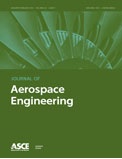 An article involving the use of RBF Morph having title “Static Aeroelastic Analysis of an Aircraft Wind-Tunnel Model by Means of Modal RBF Mesh Updating ” has been published on the journal “Journal of Aerospace Engineering” November 2016, Vol. 29, No. 6.
An article involving the use of RBF Morph having title “Static Aeroelastic Analysis of an Aircraft Wind-Tunnel Model by Means of Modal RBF Mesh Updating ” has been published on the journal “Journal of Aerospace Engineering” November 2016, Vol. 29, No. 6.
Available online at http://ascelibrary.org/doi/abs/10.1061/%28ASCE%29AS.1943-5525.0000627
(doi: 10.1061/(ASCE)AS.1943-5525.0000627)
Authors: Biancolini, M., Cella, U., Groth, C., Genta, M.
Abstract:
A numerical static aeroelastic analysis procedure, applying a modal approach in coupling the fluid dynamic and structural solutions, is presented. The method is based on a preliminary structural modal analysis from which a number of natural modes is selected to be used in the creation of a fluid dynamic domain morphing criterion. The mesh is made parametric on modal coordinates and updated using a mesh morphing tool based on radial basis functions (RBF) within the progress of the fluid dynamic computation. An intrinsically elastic numerical model is then created, and no further iteration with the structural solver is required. The modal forces are extracted by integrating the pressure on the wall boundaries and used to define the weights of the morphing action of each modal shape. This is a simplifying alternative to the traditional fluid dynamic-structural analysis coupling approach that makes it possible to bypass several complexities related to the implementation of 2-way fluid-structure interaction procedures. Furthermore, the modal approach is not affected by the error introduced by the interpolation required in the load-mapping procedure between the nonconformal fluid dynamic and structural meshes. Piaggio property static experimental measurements of a complete aircraft model in transonic conditions were used to validate the accuracy of the method. The modal solution was also compared to the one obtained by applying a traditional 2-way coupling procedure. The modal analysis was found to provide a solution extremely similar to the 2-way one also if adopting just a few modes.



